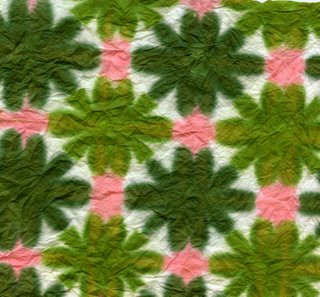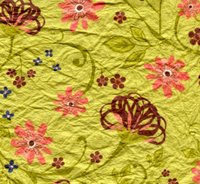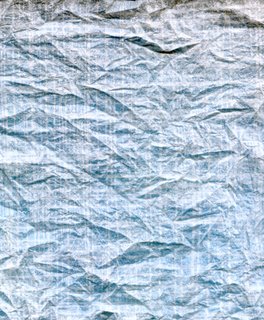 This is the eagerly awaited post about the morning half of my workshop at the JPP: konnyaku and (mainly) Japanese paper. Although this technique does not look as impressive as the beeswax technique, it is the one that I plan on using in my work on a consistent basis because I like to sew paper. Paper treated with konnyaku becomes fabric-like, allowing you to sew on fine tissues as well as sturdier papers.
This is the eagerly awaited post about the morning half of my workshop at the JPP: konnyaku and (mainly) Japanese paper. Although this technique does not look as impressive as the beeswax technique, it is the one that I plan on using in my work on a consistent basis because I like to sew paper. Paper treated with konnyaku becomes fabric-like, allowing you to sew on fine tissues as well as sturdier papers.Konnyaku is a plant used to make starch. It is used frequently in Japanese cuisine. It can also be used to treat paper. In fact, some Buddhist monks use konnyaku-treated paper to make their robes. The robe is supposed to last one year. At the end of the year, the old robe is burnt and a new one from konnyaku-treated paper is made.
The actual process is quite easy. First, you need to mix up a batch of konnyaku. Do not buy the jellied konnyaku for this. Buy the powdered starch. Also, if you can buy artist-grade konnyaku, do. You can use the food-grade konnyaku but it smells a bit like cat piss. The smell does go away as your paper dries but you're stuck with a cat-pee smell for a while. If you decide that you'd like the recipe for konnyaku, drop me an e-mail or a comment with your e-mail address and I'll send it to you. It takes about half an hour to mix up the konnyaku and another few hours for it to set. My instructor always makes her konnyaku the night before.
Once your konnyaku is ready, you can apply it to paper. Take a piece of paper and lay it out on a plexiglass board. Then, using a cheap brush, spread the konnyaku on the paper from the centre to the edges. You want the thinnest layer of goop on your paper as possible. Once you've covered once side of your paper with konnyaku, flip it and cover the other side with konnyaku. Set the paper aside to dry flat or, if you'd like really pronounced creases, fold it up or crumple it into a ball and set it aside to dry.
Before the paper has completely dried, pick it up and begin working the konnyaku into the fibres by crumpling the paper over and over again. The more you work the paper, the more like fabric it becomes. Be careful with tissues, though. They like to tear when wet.
After the konnyaku has been worked into the fibres, let the paper dry. At this point you can either leave the paper as is or you can iron it. The crumpling will be visible but the paper will be flat.
At the workshop we worked exclusively with Japanese paper because it all reacts well to the konnyaku. Western papers are more of a challenge because they all react differently. Most like to tear. The instructor told us that we should let Western papers dry almost completely before working the konnyaku into the fibres or they tear.
 I have tried the technique on scrapbooking paper and so far it's worked well. I like the patterns on some scrapbook paper but I always find them far too flat to actually incorporate into any of my work. Since konnyaku adds texture, I find it much easier to imagine using scrapbooking paper in my work. There's a scan of some treated scrapbooking paper on the left.
I have tried the technique on scrapbooking paper and so far it's worked well. I like the patterns on some scrapbook paper but I always find them far too flat to actually incorporate into any of my work. Since konnyaku adds texture, I find it much easier to imagine using scrapbooking paper in my work. There's a scan of some treated scrapbooking paper on the left.I know that it looks like crumpled paper but it's so much stronger than untreated paper that I can use finer stitches and not worry about the paper tearing.
Below are a few more scans of some of the papers I've treated with konnyaku in the past couple of weeks. I find the crumpling incredibly soothing unless I'm crumpling tissue. Then, I simply pray that it doesn't tear.
 Above is a kozo tissue in one of my favourite patterns: waves. The actual tissue is white. I had to put a coloured piece of paper behind it to make the pattern visible. I haven't tried sewing this one yet but I have some plans for this weekend. I hope.
Above is a kozo tissue in one of my favourite patterns: waves. The actual tissue is white. I had to put a coloured piece of paper behind it to make the pattern visible. I haven't tried sewing this one yet but I have some plans for this weekend. I hope. Chiyogami that's been treated. It feels like ultrasuede now.
Chiyogami that's been treated. It feels like ultrasuede now. A piece of tarasen tissue that's beem treated. It was very crisp and now it's only kind of crisp. The paper is white.
A piece of tarasen tissue that's beem treated. It was very crisp and now it's only kind of crisp. The paper is white. I admit that none of this looks particularly exciting but the prospect of sewing fine papers makes me giddy.
P.S. Is anyone signing up for this? I had seriously contemplated it but realized that with the added shipping charges, I simply cannot afford it. I do have two of her monthly cards and I love them. Why am I telling you this? Because I'd like to live vicariously through you. Please?

2 comments:
Yay! Thanks for sharing! Your paper looks great - I'd like to try it (and feel the paper)!
Do you know how long kunyaku lasts before it goes bad? I have a small container and the order is very strong, will it still work?
Post a Comment